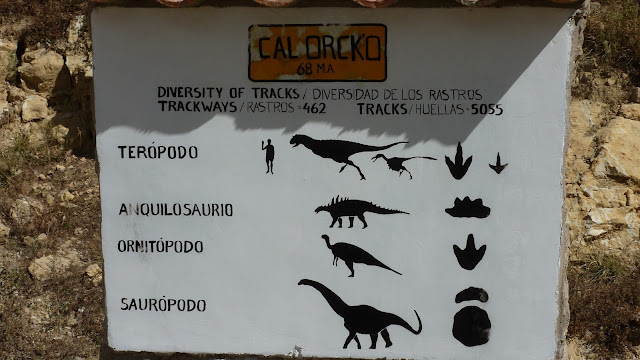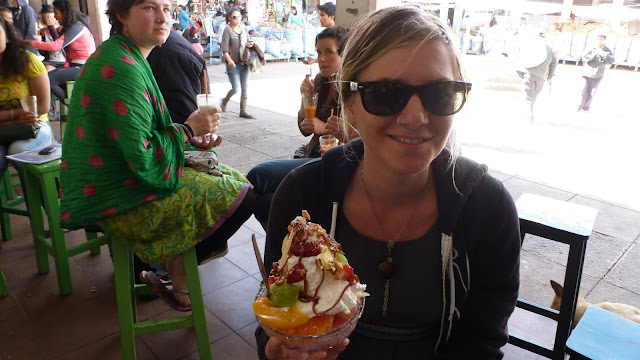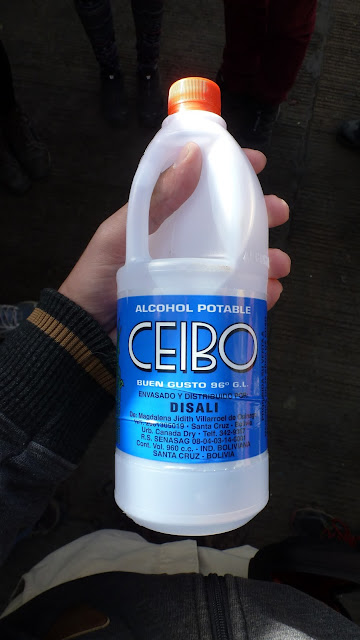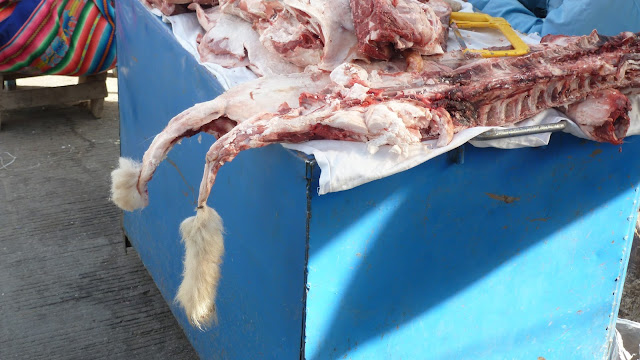The overnight bus from La Paz to Sucre was long, cold and someone (95% sure old mate sitting in front of me) stole Alex's iPod. In the bus station people were staring at us. After getting into town and securing a hostel we went out looking for breakfast at what we though was a reasonable time of 8am, hardly anywhere was open. We went to the non-profit company Condor Trekkers who offers walking tours but were told all their guides were busy that day so there were no tours. This was not the best start to Sucre. We didn't end up doing much that day. The one saviour was finding a Dutch restaurant that sold actual stroopwafles!
Day 2 was much better. After a nice breakfast that benefited local children (Condor Trekkers also has a cafe) we headed out to Parque Cretacico - the largest site of dinosaur footprints in the world.
 |
| We were greeted by this guy at the front gate |
The Park itself is some dinosaur statues dotted around a garden with facts, some fossils and a restaurant. The footprints themselves are in a quarry next door. You can see them from a viewing platform in the park with telescopes, but twice a day during the workers lunch they lead tours down into the quarry so you can get up close to the footprints.
 |
| The different types of footprints that can be seen |
We didn't realise until we were there that the footprints are actually vertical. Due to tectonic plates and all that jazz the footprints ended up being pushed up from the ground and becoming a wall. They were buried inside a mountain and were accidentally found when excavation began for the cement factory that's located on the other side of the park.
 |
| Me for scale |
 |
| The wall - you can see a few different sets of footprints heading in all different directions across the wall |
 |
| The Cement Plant that made it all possible |
With our one "big" activity out of the way we just bummed around the city for the rest of our time in Sucre, Bolivia's capital. It was a nice city with lots of historic buildings but we weren't really sure what all the fuss was about.
 |
| One of the "top" things to do in Sucre is visit the cemetery. It was actually a very nice quiet green space and it was interesting seeing the different way they have dealt with space. There are little apartment buildings for people's loved ones. |
 |
| I think the other "top" thing to do in Sucre is get a smoothie or fruit salad from the market. Although you can do this pretty much anywhere in Bolivia. I mean - look at that fruit salad! |
 |
| The Juice Ladies |
We moved on from Sucre to Potosi, 3 hours down the road the highest city in the world at 4 090 m. The main attraction of visiting Potosi is a trip down the local mine. When the Spanish invaded they discovered the near by hill was full of silver, aptly named Cerro Rico (Rich Hill). The pay load from this mine pretty much bank-rolled the Spanish invasion and much of Europe's development during the period. The town was one of harsh pain for the locals but also one of decadence as the monied (Spanish) men would splash their cash on ornate churches and other, less godly, activities.
Conditions in the mine have always been terrible. A lot of travelers have moral issues with visiting the mine because they think they are just going to be gawking at people working in poor conditions. We went with Big Deal Tours, a company run by ex-miners and we never felt this way. Our guides were fun and it was a pretty full on way to learn first hand what it's like in the mine. After about 2 hours I was pretty ready to get out of there, I came away feeling pretty grateful for what I have.
The first stop of every mining tour is the miners market. Here you can stock up on all the essentials - soft drink, coca leaves, 96% alcohol and dynamite. It's now customary to buy gifts for the miners and give them on your tour. We got a bag of coca leaves, apple juice and a colouring-in-book for the miners children. (Part of me wonders how many of these books the children have.)
 |
| Coca Leaves and the Chalk you chew them with. You add a leaf at a time to your mouth, chewing only a little, until you have a big wad in the side of your cheek. This makes your mouth numb, suppresses your appetite and allows you to work longer. You repeat this process about every four hours. |
 |
| Dynamite! |
 |
| Miners have big Friday nights on these. We all had a sip underground. Horrible horrible stuff. It keeps you warm though, very warm. |
 |
| For good measure you can also get your meat here - so fresh it's still fluffy |
After the market we got kitted up with safety gear and headed toward the hill to start our tour of the infamous mines.
 |
| They bless the mine with llama blood. Lots of llama blood |
 |
| Chilling with Tio Pachamama - the miner's god. This is who they sacrifice the llamas to |
 |
| To get from one level to another you had to crawl/slide through a pretty small tunnel. To get back up you had to crawl back the same way. |
 |
| I can't remember what these were but they were dangerous and we weren't supposed to touch it |
 |
| Helping the miners out |
The actual town of Potosi we didn't see much of. We arrived on a Sunday and Sundays in South America are dead. We headed off the day after our tour. Even if the town wasn't much it was still interesting to have been in a place that had such an affect on history.


















No comments:
Post a Comment